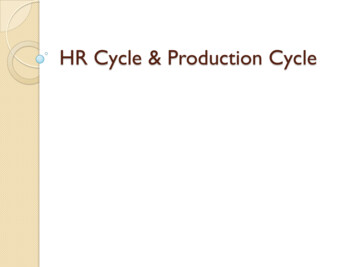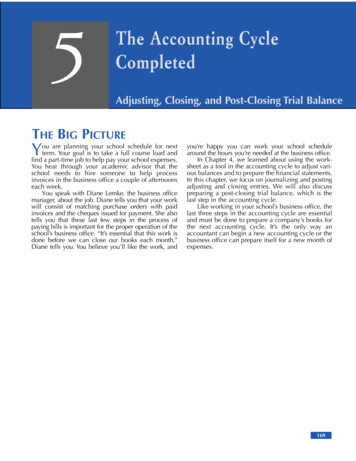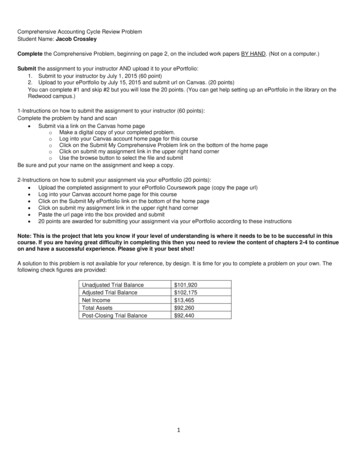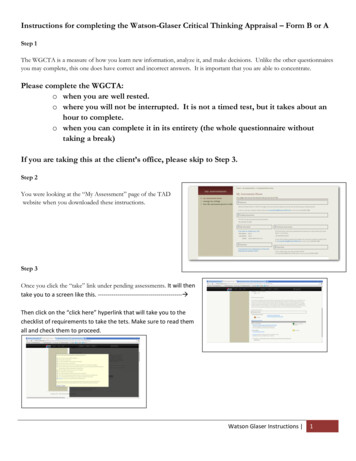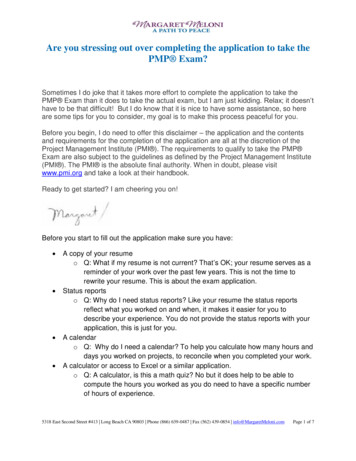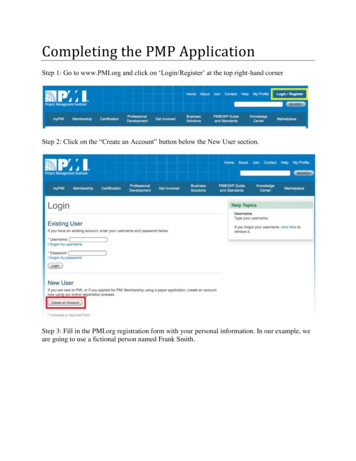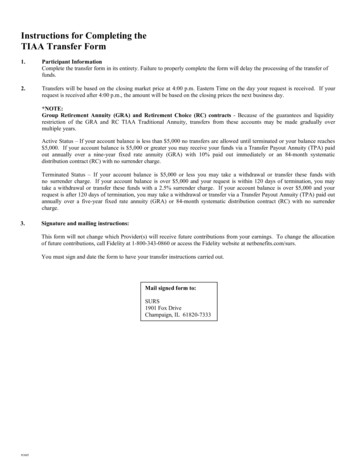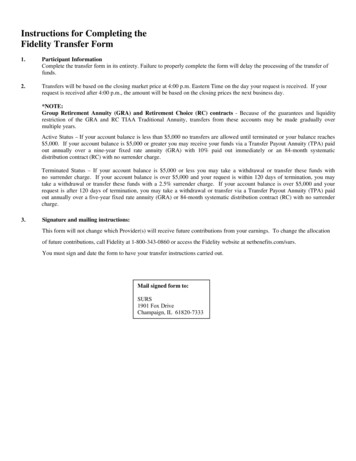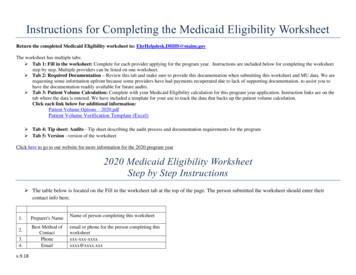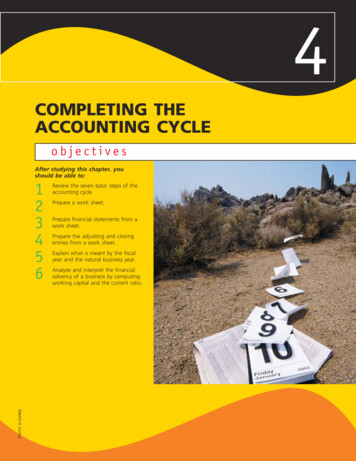
Transcription
4COMPLETING THEACCOUNTING CYCLEobjectivesAfter studying this chapter, youshould be able to:PHOTO: CORBIS123456Review the seven basic steps of theaccounting cycle.Prepare a work sheet.Prepare financial statements from awork sheet.Prepare the adjusting and closingentries from a work sheet.Explain what is meant by the fiscalyear and the natural business year.Analyze and interpret the financialsolvency of a business by computingworking capital and the current ratio.
Most of us have had to file a personal tax return. At the beginning of the year,you estimate your upcoming income and decide whether you need to increase yourpayroll tax withholdings or perhaps pay estimated taxes. During the year, you earnincome, make investments, and enter into other tax-related transactions, such as making charitable contributions. At the end of the year, your employer sends you a taxwithholding information form (W-2 form), and you collect the tax records needed forcompleting your yearly tax forms. If any tax is owed, you pay it; if you overpaid yourtaxes, you file for a refund. As the next year begins, you start the cycle all over again.Businesses also go through a cycle of activities. At the beginning of the cycle, management plans where it wants the business to go and begins the necessary actionsto achieve its operating goals. Throughout the cycle, which is normally one year, theaccountant records the operating activities (transactions) of the business. At the endof the cycle, the accountant prepares financial statements that summarize the operating activities for the year. The accountant then prepares the accounts for recordingthe operating activities in the next cycle.As we saw in Chapter 1, the initial cycle for NetSolutions began with Chris Clark’sinvestment in the business on November 1, 2005. The cycle continued with recording NetSolutions’ transactions for November and December, as we discussed in Chapters 1 and 2. In Chapter 3, the cycle continued and we recorded the adjusting entriesfor the two months ending December 31, 2005. Now, in this chapter, we discuss theflow of the adjustment data into the accounts and into the financial statements.Accounting CycleThe accounting process that begins with analyzing and journalizing transactions andends with summarizing and reporting these transactions is called the accountingcycle. The most important output of this cycle is the financial statements.Review the seven basic stepsof the accounting cycle.The basic steps of the accounting cycle are shown, by number, in the flowchartin Exhibit 1.In earlier chapters, we described and illustrated the analysis and recordIn a computerized accounting sysing of transactions, posting to the ledger, preparing a trial balance, anatem, the software automaticallylyzing adjustment data, preparing adjusting entries, and preparing financialrecords and posts transactions.statements. In this chapter, we complete our discussion of the accountingThe ledger and supporting recordscycle by describing how work sheets may be used as an aid in preparingare maintained in computerizedthe financial statements. We also describe and illustrate how closing entriesmaster files. In addition, a worksheet is normally not prepared.and a post-closing trial balance are used in preparing the accounting recordsfor the next period.objective1Work Sheetobjective2Prepare a work sheet.Common spreadsheet programs usedin business includeMicrosoft Excel andLotus 1-2-3 .Accountants often use working papers for collecting and summarizing data theyneed for preparing various analyses and reports. Such working papers are usefultools, but they are not considered a part of the formal accounting records. This isin contrast to the chart of accounts, the journal, and the ledger, which are essentialparts of the accounting system. Working papers are usually prepared by using aspreadsheet program on a computer.The work sheet is a working paper that accountants can use to summarize adjusting entries and the account balances for the financial statements. In small companies with few accounts and adjustments, a work sheet may not be necessary. Forexample, the financial statements for NetSolutions can be prepared directly from theadjusted trial balance illustrated in Chapter 3. In a computerized accounting system,
141Chapter 4 Completing the Accounting Cycle Exhibit 1Accounting Cycle②Accts. Rec. 112①⑤Cash 111⑥Source DocumentsJournalLedger⑦③XYZ Co.Work SheetFor the Period Ended December 31, 20––XYZ Co.Post-Closing Trial BalanceDecember 31, 20––TrialBalancePost-ClosingTrial Balance⑤AdjustmentsAdjustedTrialBalanceWork lance Sheet① Transactions are analyzed and recorded in the journal.② Transactions are posted to the ledger.③ A trial balance is prepared, adjustment data are④⑤⑥⑦assembled, and an optional work sheet is completed.Financial statements are prepared.Adjusting entries are journalized and posted to the ledger.Closing entries are journalized and posted to the ledger.A post-closing trial balance is prepared.a work sheet may not be necessary because the software program automaticallyposts entries to the accounts and preparesfinancial statements.The work sheet (Exhibits 2 through 5on pages 142–146) is a useful device forunderstanding the flow of the accountingdata from the unadjusted trial balance tothe financial statements (Exhibit 6). Thisflow of data is the same in either a manual or a computerized accounting system.Statement ofOwner's EquityIncome StatementFinancial StatementsThe work sheet is a usefuldevice for understandingthe flow of the accountingdata from the unadjustedtrial balance to the financialstatements.Unadjusted Trial Balance ColumnsTo begin the work sheet, list at the top the name of the business, the type ofworking paper (work sheet), and the period of time, as shown in Exhibit 2. Next,enter the unadjusted trial balance directly on the work sheet. The work sheet inExhibit 2 shows the unadjusted trial balance for NetSolutions at December 31,2005.
142Chapter 4 Completing the Accounting Cycle Exhibit 2Work Sheet with Unadjusted Trial Balance EnteredNetSolutionsWork SheetFor the Two Months Ended December 31, 2005Trial BalanceAccount Title1 Cash2 Accounts Receivable3 Supplies4 Prepaid Insurance5 Land6 Office EquipmentDr.9 Chris Clark, Capital14 Utilities Expense15 Supplies Expense16 Miscellaneous Expense17Dr.Dr.Cr.Dr.Cr.234The work sheet is used for summarizing the effects of adjustingentries. It also aids in preparingfinancial r.Balance Sheet14,00011 Fees Earned13 Rent ExpenseCr.IncomeStatement90036025,0008 Unearned Rent12 Wages ExpenseDr.AdjustedTrial Balance2,0652,2202,0002,40020,0001,8007 Accounts Payable10 Chris Clark, tments ColumnsThe adjustments that we explained and illustrated for NetSolutions in Chapter 3 areentered in the Adjustments columns, as shown in Exhibit 3. Cross-referencing (byletters) the debit and credit of each adjustment is useful in reviewing the work sheet.It is also helpful for identifying the adjusting entries that need to be recorded in thejournal.The order in which the adjustments are entered on the work sheet is not important. Most accountants enter the adjustments in the order in which the data areassembled. If the titles of some of the accounts to be adjusted do not appear in thetrial balance, they should be inserted in the Account Title column, below the trialbalance totals, as needed.To review, the entries in the Adjustments columns of the work sheet are:(a) Supplies. The supplies account has a debit balance of 2,000. The cost of thesupplies on hand at the end of the period is 760. Therefore, the suppliesexpense for December is the difference between the two amounts, or 1,240.Enter the adjustment by writing (1) 1,240 in the Adjustments Debit column onthe same line as Supplies Expense and (2) 1,240 in the Adjustments Creditcolumn on the same line as Supplies.(b) Prepaid Insurance. The prepaid insurance account has a debit balance of 2,400, which represents the prepayment of insurance for 24 months beginningDecember 1. Thus, the insurance expense for December is 100 ( 2,400/24).Enter the adjustment by writing (1) 100 in the Adjustments Debit column on
Chapter 4 Completing the Accounting Cycle(c)(d)(e)(f)143the same line as Insurance Expense and (2) 100 in the Adjustments Creditcolumn on the same line as Prepaid Insurance.Unearned Rent. The unearned rent account has a credit balance of 360, whichrepresents the receipt of three months’ rent, beginning with December. Thus,the rent revenue for December is 120. Enter the adjustment by writing (1) 120in the Adjustments Debit column on the same line as Unearned Rent and (2) 120 in the Adjustments Credit column on the same line as Rent Revenue.Wages. Wages accrued but not paid at the end of December total 250. Thisamount is an increase in expenses and an increase in liabilities. Enter the adjustment by writing (1) 250 in the Adjustments Debit column on the same lineas Wages Expense and (2) 250 in the Adjustments Credit column on the sameline as Wages Payable.Accrued Fees. Fees accrued at the end of December but not recorded total 500. This amount is an increase in an asset and an increase in revenue. Enterthe adjustment by writing (1) 500 in the Adjustments Debit column on the sameline as Accounts Receivable and (2) 500 in the Adjustments Credit column onthe same line as Fees Earned.Depreciation. Depreciation of the office equipment is 50 for December. Enterthe adjustment by writing (1) 50 in the Adjustments Debit column on the sameline as Depreciation Expense and (2) 50 in the Adjustments Credit column onthe same line as Accumulated Depreciation.Total the Adjustments columns to verify the mathematical accuracy of the adjustment data. The total of the Debit column must equal the total of the Credit column.Adjusted Trial Balance ColumnsThe adjustment data are added to or subtracted from the amounts in the unadjustedTrial Balance columns. The adjusted amounts are then extended to (placed in) theAdjusted Trial Balance columns, as shown in Exhibit 3. For example, the cashamount of 2,065 is extended to the Adjusted Trial Balance Debit column, sinceno adjustments affected Cash. Accounts Receivable has an initial balance of 2,220and a debit adjustment (increase) of 500. The amount to write in the AdjustedTrial Balance Debit column is the debit balance of 2,720. The same procedurecontinues until all account balances are extended to the Adjusted Trial Balancecolumns. Total the columns of the Adjusted Trial Balance to verify the equality ofdebits and credits.Income Statement and Balance SheetColumnsThe work sheet is completed by extending the adjusted trial balance amounts to theIncome Statement and Balance Sheet columns. The amounts for revenues and expenses are extended to the Income Statement columns. The amounts for assets, liabilities, owner’s capital, and drawing are extended to the Balance Sheet columns.1In the NetSolutions work sheet, the first account listed is Cash, and the balanceappearing in the Adjusted Trial Balance Debit column is 2,065. Cash is an asset,is listed on the balance sheet, and has a debit balance. Therefore, 2,065 is extended to the Balance Sheet Debit column. The Fees Earned balance of 16,840 isextended to the Income Statement Credit column. The same procedure continuesuntil all account balances have been extended to the proper columns, as shown inExhibit 4.After all of the balances have been extended to the four statement columns, total each of these columns, as shown in Exhibit 5. The difference between the two1The balances of the capital and drawing accounts are also extended to the Balance Sheet columns because this worksheet does not provide for separate Statement of Owner’s Equity columns.
144Chapter 4 Completing the Accounting Cycle Exhibit 3Work Sheet with Unadjusted Trial Balance, Adjustments, and Adjusted TrialBalance EnteredNetSolutionsWork SheetFor the Two Months Ended December 31, 2005Trial BalanceAccount Title1 Cash2 Accounts Receivable3 Supplies4 Prepaid Insurance5 Land6 Office EquipmentDr.7 Accounts Payable9 Chris Clark, Capital13 Rent Expense14 Utilities Expense15 Supplies Expense16 Miscellaneous Expense1718 Insurance ExpenseDr.(a)1,240(b) 100Cr.Balance SheetDr.Cr.123The adjustments on thework sheet are used inpreparing the adjustingjournal entries.(e) 500(d) 250100(c) 120(d) 250(f)5022 Accumulated Depreciation2,260502,26012025043,400711The adjusted trial balanceamounts are determined byadding the adjustments to orsubtracting the adjustments fromthe trial balance amounts. Forexample, the Wages Expensedebit of 4,525 is the trial balance amount of 4,275 plus the 250 adjustment debit.50(f)6916,84042,600(b) 2751,60098580045542,600Cr.90024025,00012020 Wages Payable23Dr.2,0652,7207602,30020,0001,800(e) 50019 Rent Revenue21 Depreciation ExpenseCr.4,00011 Fees Earned12 Wages ExpenseIncomeStatementDr.900360 (c)25,0008 Unearned Rent10 Chris Clark, rial 24242525Accounts are added, asneeded, to complete theadjustments.Income Statement column totals is the amount of the net income or the net loss forthe period. Likewise, the difference between the two Balance Sheet column totalsis also the amount of the net income or net loss for the period.If the Income Statement Credit column total (representing total revenue) is greaterthan the Income Statement Debit column total (representing total expenses), the difference is the net income. If the Income Statement Debit column total is greaterthan the Income Statement Credit column total, the difference is a net loss. For NetSolutions, the computation of net income is as follows:Total of Credit column (revenues)Total
ACCOUNTING CYCLE After studying this chapter, you should be able to: 1 Review the seven basic steps of the accounting cycle. 2 Prepare a work sheet. 3 Prepare financial statements from a work sheet. 4 Prepare the adjusting and closing entries from a work sheet. 5 Explain what is meant by the fiscal year and the natural business year.File Size: 1023KBPage Count: 49

